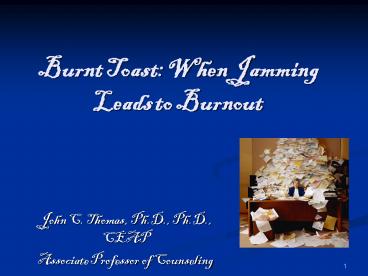Burnt Toast: When Jamming Leads to Burnout - PowerPoint PPT Presentation
1 / 26
Title:
Burnt Toast: When Jamming Leads to Burnout
Description:
3. Not simply excessive stress. A complex human reaction to on-going stress ... The Fallout of Burnout. Frustration replaces Challenge. Fear replaces Courage ... – PowerPoint PPT presentation
Number of Views:109
Avg rating:3.0/5.0
Title: Burnt Toast: When Jamming Leads to Burnout
1
Burnt Toast When Jamming Leads to Burnout
- John C. Thomas, Ph.D., Ph.D., CEAP
- Associate Professor of Counseling
2
- What is stressful about being an EAP
professional? - What is stressful about working with business and
industry?
3
What is Burnout?
- Not simply excessive stress
- A complex human reaction to on-going stress
- It is not so much a state or condition, but a
process that can lead to impairment - Occurs when the EAPs inner resources are
inadequate for managing tasks and situations
4
What is Burnout? (cont)
- A state of fatigue or frustration brought about
by a devotion to a cause, a way of life, or a
relationship that failed to produce the expected
reward. (Freudenberger) - Characterized by emotional exhaustion,
depersonalization, and decreased sense of
personal accomplishment (Maslach Jackson)
5
What is Burnout?
- Condition of feeling wasted physically,
emotionally, spiritually, interpersonally, and
behaviorally (MacClusky Ingersoll) - An erosion of the spirit
6
Burnout Formula
High Ideals and Motivation
__
Depletion of Spirit and Faith in our Capacity to
make a Difference
7
Hazards of the EAP
Professional Contributors
- Vicarious traumatization
- Dealing with significant client pathology
- One way intimacy and voyeuristic work
- Highly demanding profession (e.g., on call,
ethical/legal) - Conflicting clinical needs and insurance benefits
- Reputation assaults
- Threat of lawsuits
- Salary and perk issues
- Multiplicity of roles
- Administration vs. clinical overload
- Working alone / isolation
- Job security
- Interruptions
8
Hazards of the EAP
Organizational Contributors
- Job intensity (workload)
- Administrative support
- Feedback
- Social support from colleagues
- Confidence in leadership
- Adequacy of supervision
- Politics
- Organizational climate
- Poor reward system
- Unfairness
- Hierarchically control decision-making
- Unethical
9
Hazards of the EAP
Individual Vulnerability Contributors
- Pessimistic
- Lack of intimacy in personal life
- Workaholic mentality
- Confusion of role identity with self-image
- Fragile self-esteem
- Need to rescue others
- Perceived need for approval / acceptance
- Conscientiousness
- Attributional style
10
Hazards of the EAP
Cognitive Contributors
- Unresolved countertransference
- Perceived control of work environment
- Identification with clients
- Psychological magnification
- Deriving too much self-esteem from work
- Disparity between expectations and reality
- Taking self too seriously
- Negativity
11
Hazards of the EAP
Behavioral Contributors
- Inability to shut off therapeutic stance
- Interference from personal lives (balance)
- Poorly defined boundaries
- Time management problems
- Poor social support
- Poor coping strategies
12
Hazards of the EAP
Emotional Contributors
- On-going feelings of frustration
- Level of anger and irritability
- Feelings associated with clients not getting
better - Overwhelmed
13
Stages of Burnout
14
Stages of Burnout
Irritable, Anxious, HBP, Increased Heart
Rate Bruxism, Insomnia, Headaches, Forgetful,
Poor Concentration,
15
Stages of Burnout
Late for Work, Apathy, Procrastinate, Fatigue,
Cynical, Resentful, Need 3 Day Weekends,
Isolation, Drink More, Miss Deadlines
16
Stages of Burnout
Chronic Sadness or Depression, Headaches, Mental
Fatigue, Desire to Drop Out, GI Problems, Numb
17
Burnout Fallout
Physical Fallout
- Chronic fatigue
- Lower illness resistance
- Substance abuse
- Malaise
- GI problems
- Insomnia
- HBP
- Tachycardia
- Cholesterol problems
- Headaches
- Exhaustion
- Long term to rebound
18
Burnout Fallout
Emotional Fallout
- Suppress emotion
- Discouraged
- Anxious
- Resentment
- Guilt / Shame
- Liability
- Chronic sadness
- Depression
- Emotional exhaustion
- Apathy
- Helplessness
- Powerless
- Despair
19
Burnout Fallout
Cognitive Fallout
- Cynicism
- Sense of inefficiency
- Sense of failure
- Stereotyping
- Loss of creativity
- Resisting change
- Depersonalizing clients
- Wanting to drop out
- Resistance in going to work
- Self-preoccupation
- Rigidity in thinking
- Spiritual deadness
- Negativity
20
Burnout Fallout
Behavioral Fallout
- Complaining
- Blaming
- Late to work
- Absenteeism
- Withdrawing / Isolation
- Clock watching
- Postponing phone calls
- Assuming additional responsibility
- Sacrifice life for work
- Cannot say no
- Substance abuse
- Relationship problems
- Act out
21
The Fallout of Burnout
- Frustration replaces Challenge
- Fear replaces Courage
- Cynicism replace Compassion
- Carelessness replaces Caution
- Convention replaces Creativity
- Compromise replaces Conviction
- Disengagement replaces Collaboration
- Depersonalization replaces Community
- Liability replaces Control
- Exhaustion replaces Charge (Energy)
- Apathy replaces Commitment (Enthusiasm)
- Ineffectiveness replaces Competence
22
Why Change Doesnt Occur
- We automatically follow our old unconscious
maps - These old maps continue to drive behavior since
- we have experience with them
- we do not have experience with alternate behavior
- Burned-out people do not believe they can change
or need to change - Low energy
23
Preventing Burnout PREVENTIONS
- Probe (self-assess)
- Resourcefulness (commitment)
- Evolve (grow / counseling)
- Vitality (health)
- Entertainment (leisure / fun)
- Network (social support)
- Time-Out (relax refuel)
- Influence (locus of control)
- Off-Load (margin)
- Needs Met
24
Personal Needs
- Acceptance
- Approval
- Affection
- Achievement
- Autonomy
25
Preventing Burnout PREVENTIONS
- Probe (self-assess)
- Resourcefulness (commitment)
- Evolve (grow / counseling)
- Vitality (health)
- Entertainment (leisure / fun)
- Network (social support)
- Time-Out (relax refuel)
- Influence (locus of control)
- Off-Load (margin)
- Needs Met
- Spirituality (faith)
26
Preventing Burnout at Work
- Job Fit
- Orientation to the Future
- Balanced Decision-Making
- Workload Allocation
- Engagement with Work
- Legitimacy (fairness)
- Limit Job Spillover
- Network (community)
- Evaluate the Organization
- Supervisory Support
- System of Reward































